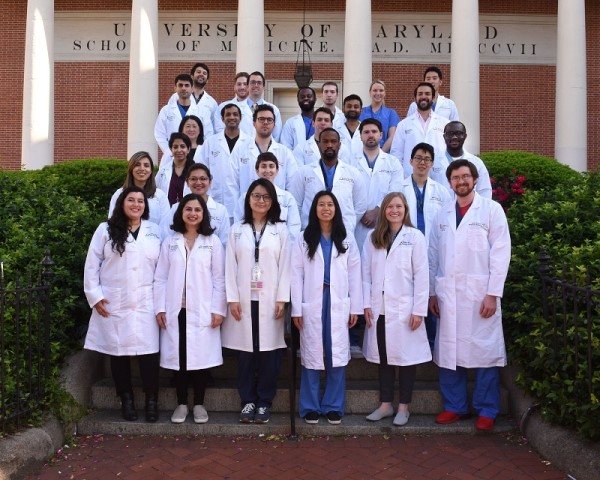Meet the Residents - Diagnostic Radiology Residency

In the Department of Radiology at the University of Maryland Medical Center, fun is always a part of our daily activities. We enjoy our work, and we do a great job supporting each other. The first year residents can rely on more senior residents for mentoring and guidance. The upper year residents "have each other's back" for call duties. The fourth year residents enjoy a flexible schedule with their choice of electives or mini-fellowships and a lot of time for research.
Resident Resources
We have a large state-of-the-art conference room with three overhead HD projectors. Across from the conference room is the resident learning center (RLC) equipped with computers, desks, conference table, and textbooks. There is also a resident lounge with a kitchen area, lockers, and couches. Each resident receives a $2,000 educational stipend. These funds can be spent at the discretion of the resident for educational materials and textbooks. Residents also receive free access to STATdx and RADPrimer, and fees for the American Board of Radiology (ABR) are paid by the department. Funding is available for residents presenting at national conferences such as RSNA (Radiological Society of North America), AUR (Association of University Radiologists), ARRS (American Roentgen Ray Society), SPR (Society for Pediatric Radiology), SIR (Society Of Interventional Radiology), and ASHNR (American Society of Head and Neck Radiology), among others.
Salary and Benefits
University of Maryland Medical Center Resident Salary and Benefits Information
International Opportunities
RAD-AID International is a non-profit organization whose mission is to increase radiology's contribution to global public health initiatives by optimizing access to medical imaging in developing regions of the world. In 2013, our radiology residents and faculty founded a RAD-AID chapter at the University of Maryland Medical Center. Since then, we have created a dedicated longitudinal global health curriculum for interested trainees to gain competence in global health education. The curriculum offers a tailored experience to learn about and opportunity to travel to a country of the trainee's choice to positively impact global healthcare education and quality specifically through radiology services. So far, we have focused our efforts in Lagos, Nigeria and Johannesburg, South Africa. We plan to travel to Ghana and India in the future based upon resident preference.
Additionally, there is a yearly RAD-AID conference attended by several of our residents as well as individuals from multiple medical specialties and government sectors. Conference topics range from global community service to international, economic development strategies. For more information about the annual RADAID conference, visit the RAD-AID website.
Our program also has a Health4TheWorld chapter. Through this initiative, our faculty give lectures across the globe on various radiology topics, and residents have the opportunity to record lectures to be posted on their website. This allows us to promote global health and make a positive educational impact abroad.
Women in Radiology
Women remain under-represented in the field of radiology, despite recent improvements. Our program is proud to have a greater percentage of women residents than the national average, including multiple women in each residency class. Women faculty, fellows, and residents have frequent social gatherings, and multiple female faculty members have formally and informally mentored residents.
Fellowships of Recent Residents
While some residents have chosen to stay at the University of Maryland for fellowships in almost every subspecialty (including our highly acclaimed informatics fellowship), many choose to pursue fellowships at other prestigious institutions. Fellowships of recent UMMC resident classes include the following:
